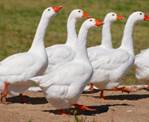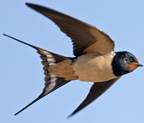Abstract
The research is based on the modern theory of interpretation. The formation of interpretive meanings is based on conceptual derivation enabled by the cognitive mechanisms of metaphor, metonymy and metaphtonymy. It is noted that metaphor has the leading role. This article describes the relationships between both parts of compound nouns with the bird names. It is most important is to study the formation of secondary meanings of these birds’ names, depending on the semantic structure of the noun. The work considers 5 cognitive areas to which these complex nouns belong: plants, animals, people, artifacts and body parts. Therefore, the source domain of interpretation is ‘birds’ and the target domain is plants, animals, humans, things and body parts. In most examples, the bird's name acts as the defining part of the compound nouns. This means that the referent, characterized by the composite, receives some of the characteristics of birds. The urgency of this research is determined by its theoretical prerequisites based on the principles of the cognitive approach. This fact allows dealing with specificity of interpretive activity of human’s mind in the view of mental and language structures relation. The research made on German contributes to our understanding of the universal character of the basic principles, cognitive mechanisms and interpretive formats of knowledge of lexical categories determining the processes of interpretive conceptualization and categorization.
Keywords: Theory of interpretationconceptual derivationbird namescognitive metaphormetonymymetaphtonymy
Introduction
In this work the possibilities of the formation of secondary meanings of complex adjectives containing an animal name are explored. Different source and target domains determine the outer vector of interpretation between the cognitive domain "animals" and other domains. The theoretical approach of this investigation is based on the concept of interpretation, as an arbitrary thought activity of a man, which is directed to new knowledge (Panasenko, 2016). The term "language interpretation" is understood to mean a cognitive activity based on conceptual derivation, which manifests itself in the evolution of the content from the original concepts through the confirmation of the connection between the corresponding cognitive domains (Boldyrev & Aleksikova, 2010).
The change of the content is the cause of the concept "conceptual net", which explains the mechanisms of meaning formation. This network contains four types of spaces: a generic space, two input spaces and a blend (Fauconnier, 1997). Between the input spaces, the conceptual connections are formed by the choice of features that can be considered integrative for any conceptual field. These features form the possibility of the concept for interpretation.
It is necessary to note that the comparison of two thematic areas is based on the analogy of some of their characteristics or properties (Boldyrev, 2014). That is, interpretation presupposes a degree of ontological affinity.
The variety of features of the interpretation objects leaves the presence of different formats of knowledge interpretation:
the format of perception;
the format of observation;
the format of function;
the format of operational experience;
the format of function, etc. (Panasenko, 2016).
In this article, the format of perception plays a special role. The perception of the perceived feature has a psychological reason and, by and large, means the perception of the feature by the sensory organs (Gamezo, 2001). The visual sense is considered particularly strong. The visual perception provides relevant information about a large spatial area of our environment.
Problem Statement
The current stage of research of the language system is focused on the study of the specifics of language as one of the cognitive subsystems and the role that is actually a fact of language forms in conceptualization. The analysis of the interpretive potential of language units allows taking a fresh look at the structure of lexical categories. In addition, there are currently not enough studies in this area based on the German language.
Research Questions
As an empirical material of this work, compounds were chosen. The composition as a way of word formation means the connection of independent words to a new word. This type of word formation is very old in the German language and still plays a big role (Stepanova, 1953). The structure of the compounds indicates the presence or absence of the so-called "head" of the compound. In the case of presence, this compound word is called "the determinative composite". This is a compound in which a subordinate or subordinate relationship arises between the connected words (Kessel & Reinmann, 2005).
The formation of secondary values of animal names as part of compound nouns occurs through cognitive mechanism of metaphors, metonymy and metaphtonymy.
Metonymy is a cognitive process in which one conceptual entity, means, provides mental access to another object, target, in the same domain (Kövecses & Radden, 1998). Metonymy is a way of building an image. The mechanism of metonymic reinterpretation is the transfer of the names of phenomena, objects and their signs in accordance with contiguity or in a broader sense - in accordance with their relations in space and time. Metonymy draws attention to an individual trait that allows the addressee of speech to identify an object, distinguish it from the region of the observed and distinguish it from other objects that exist with it (Arutiunova, 1990).
In modern cognitive science, it is customary to define a metaphor as a (main) mental operation, as a way of cognizing, categorizing, conceptualizing, evaluating and explaining the world (Chudinov & Budaev, 2007). J. Tailor notes that metaphor proves to be good example of imaginative schematic operations because it allows us a glimpse of the creation of meaningful structure via projections and elaborations of image schemata (Johnson, 1987). A metaphor makes us attend to some similarities, often a novel or surprising, between two or more things. This observation leads to a conclusion concerning the meaning of metaphors (Davidson, 1978).
The term metaphthonymy was coined by Goossens less than 20 years ago. He defines its status as cover term which should help to increase our awareness of the fact that metaphor and metonymy can be intertwined (Goossens, 2003). In metaphthonymy, both associative relationships are found in similarity (the interaction of two conceptual concepts related to different conceptual spaces) and in adjacency (the interaction of two conceptually close entities within the same conceptual space). Moreover, the elements of the sphere have a source of metonymic expansion or metonymic basis. Metaphthonymy is found in models that can be schematically represented in the form of schemes: (A instead of B) + (A is B) = X, where (A instead of B) is a scheme of conceptual metonymic connections, and (A is B) is a scheme of conceptual metaphorical connections. Metaphthonymy “X” arises as a result of conceptual metonymic connections with metaphorical (Sharmanova, 2016).
Purpose of the Study
The purpose of the study is the analysis of the possibility of forming the secondary meanings of bird names as a part of compound nouns.
Research Methods
-
During the research the following methods were used:
-
method of dictionary definition analysis;
-
method of contextual analysis;
-
method of component analysis;
-
method of comparative analysis.
Findings
Names of Plants
The source domain ‘bird’ and target domain ‘plant’ determine the outer vector of interpretation. Among the names of plants containing an element
The most obscured is the motivation of the nomination of the name
It is also very important that the format of perception can be organically combined with other formats of interpreting attributes (Figure
To confirm this statement, we can consider the name of plant


Among the perceptual signs, we should note the color and texture, i.e. the quality of the plant shell; however, the form became the dominant perceptual attribute. Metaphorical transfer based on a common color is carried out in the name
The transfer of the animals attribute by the name
The name
Names of Animals
The source domain ‘bird’ and target domain ‘animal’ determine the inner vector of interpretation because birds belong to the animal world.
Let us turn to the name
The sign "color" would allow transferring in the name


Schwalbenschwanz (Papilio machaon) contains a direct indication of that part of the animal’s body that allows transferring of the attribute. If the swallowtail calls Schwalbenschmetterling (swallow + butterfly), then for a correct interpretation, deep knowledge of entomology would be necessary that the butterfly has short black tails that look like the tail of a swallow (Bellmann, 2003). In this case, the attribute by which the transfer was carried out was ‘form’ and ‘color’.
Human Names
The two discovered names of a person are not similar, since one of them is the proper name of a folklore character, and the second one is a common name.
The compound noun
The name
1) a direct translation of the low German concepts of
2) the metaphorical meanings of the word
3) naming by resemblance to the face of an owl;
4) an owl as a representative of gloomy night images, and a mirror as a tool of scammers and charlatans (Wunderlich, 1984).
Each hypothesis involves certain formats and cognitive interpretation mechanisms. Omitting the first hypothesis, since it does not contain a name of an animal, we note that the second and fourth ones show interpretation through metaphor because the word
In this case, the interpretation is carried out according to the observation format through conceptual derivation, in which, using a conceptual metaphor; a transfer is made from the animal world to the sphere of abstract concepts.


The second example is the compound noun Elefantenküken (clumsy teenager). Perceptual characteristics don’t play a role, since the composite does not include meaning ‘large size’, which means that the first part is interpreted using the observation format based on ‘clumsy movements’. The second component has a secondary meaning ‘young inexperienced girl’, so the total value is made up of signs ‘clumsy’ + ‘young’.
Names of artifakts
The examples of this group can be divided into two groups according to the value of the components:
The word
The first meaning of the word
The next examples
Names of body parts
The following four examples are designations of parts of the human body that have common features with the corresponding parts of the body in animals. However, in contrast to the above-described example with the word Schwalbenwurz, in this case only the mechanism of metaphor functions, since compound nouns denote not the whole person, but only his part, so there is not the metonymic transfer PART-WHOLE.
The words Adlerauge (keen eye), Rabenhaar (black hair) and Straußenmagen (digestion of an ostrich) denote the part of human body, in this case, the names of animals in the composition of the compound noun do not receive a secondary value, because they indicate only the belonging of a given part of the body to a specific animal. The second value of the bird name would be possible, if there were the second values of the bird names in the language, for example, Adler – keen person, so Adlerauge – the eye of the keen person.
The last example in this group Taubebherz (soft heart) is the most interesting because denotes not a physical characteristic, but a character trait. The heart in this case acts in its secondary meaning as a source of kindness. The last examples show only metaphorical transfer from source to target, but now we can see the transfer of the meaning of the word heart, when it belongs to a bird and to a person.
Conclusion
The interpretation of bird names in complex nouns is carried out through various formats, the most common of which is the perception format. Actual material showed the possibility of implementing external and internal interpretation vectors. Some examples illustrate various ways of understanding the interpretation of a bird name's meaning. Thus, the study of the interpretive potential of animals as part of compound nouns is a wide field for research.
References
- Arutiunova, N. D. (1990). Metaphor and discourse. Theory of Metaphor. Moscow: Progress.
- Bellmann, H. (2003). Der Neue Kosmos Schmetterlingsführer, Schmetterlinge, Raupen und Futterpflanzen [The new universe butterfly's leader, butterflies, caterpillars and forage crops]. Stuttgart: Franckh-Kosmos Verlags-GmbH & Co.
- Boldyrev, N. N. (2014). The role of the cognitive context in the interpretation of the world and knowledge of the world. Bulletin of ChelSU, 6(335), 118-122.
- Boldyrev, N. N., & Aleksikova, Y. V. (2010). The cognitive aspect of euphemization (based on English). Issues of cognitive linguistics, 2, 5–11.
- Chudinov, A. P., & Budaev, E. V. (2007). The formation and evolution of the cognitive approach to metaphor. New Philological Bulletin, 1(4), 8–27.
- Davidson, D. (1978). What Metaphors Mean. Critical Inquiry, 5(1), 31–47.
- Fauconnier, G. (1997). Mappings in Thought and Language. Cambridge.
- Gamezo, M. V. (2001). Dictionary of educational psychology. Moscow: Pedagogical Society of Russia.
- Goossens, L. (2003). Metaphtonymy: The interaction of metaphor and metonymy in expression for linguistic action. In R. P. René (Ed.), Metonymy and metaphor: Conceptualisation strategies. Berlin: Mouton de Gruyte.
- Götzinger, E. (1885). Reallexikon der Deutschen Altertümer [Specialist encyclopaedia of the German antiquities]. Umgearb. Leipzig: Aufl. Urban.
- Johnson, M. (1987). The Body in the Mind: The Bodily Basis of Meaning, Imagination, and Reason. Chicago: University of Chicago Press.
- Kessel, K., & Reinmann, S. (2005). Basiswissen Deutsche Gegenwartssprache [Basics German present-day language]. Tübingen und Basel, A. Francke Verlag.
- Kövecses, Z., & Radden, G. (1998). Metonymy: developing a cognitive linguistic view. Cognitive Linguist., 9-1, 37–77.
- Panasenko, L. A. (2016). The interpretative potential of lexical categories: monograph. Tambov: Publishing House Pershina R.V.
- Sebald, O. (1989). Wegweiser durch die Natur. Wildpflanzen Mitteleuropas [Signpost by the nature. Wild plants of Central Europe]. München: ADAC Verlag.
- Sharmanova, O. S. (2016) Features of the interaction and integration of metaphors and metonyms as a way of forming metaphtonymy. Bulletin of the Voronezh State University. Linguistics and Intercultural Communication, 3, 11–14.
- Stepanova, M. D. (1953). Word formation of the modern German language. Moscow: Publishing house of literature in foreign languages.
- Wunderlich, W. (1984). Till Eulenspiegel [Till Eulenspiegel]. München: Wilhelm Fink Verlag.
Copyright information

This work is licensed under a Creative Commons Attribution-NonCommercial-NoDerivatives 4.0 International License.
About this article
Publication Date
31 October 2020
Article Doi
eBook ISBN
978-1-80296-091-4
Publisher
European Publisher
Volume
92
Print ISBN (optional)
-
Edition Number
1st Edition
Pages
1-3929
Subjects
Sociolinguistics, linguistics, semantics, discourse analysis, translation, interpretation
Cite this article as:
Andreevna, Z. M., & Borisovna, R. E. (2020). Interpretative Potential Of Bird Names As Part Of Complex Nouns In German. In D. K. Bataev (Ed.), Social and Cultural Transformations in the Context of Modern Globalism» Dedicated to the 80th Anniversary of Turkayev Hassan Vakhitovich, vol 92. European Proceedings of Social and Behavioural Sciences (pp. 3505-3512). European Publisher. https://doi.org/10.15405/epsbs.2020.10.05.466

